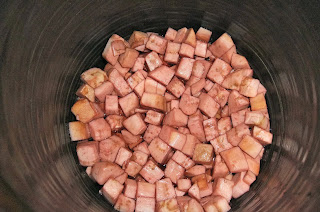I am moved into my new home – albeit not completely unpacked and organized, yet – the holiday season has passed, and I have slowed down on my canning and preserving, so I finally have a few moments to post some more recipes and photos from all my small batches I put by at the end of the harvest season!
I really, really like eggplant. I like it as parmigiana or as a grinder, sprinkled on an antipasto salad, on bruschetta or focaccia – or if it is Preserved Italian Style in oil, sometimes I like it straight from the jar.
 |
| A variety of eggplants and tomatoes, fresh from the garden, ready for preserving. |
The problem here in the United States is that when you preserve certain vegetables in oil the U.S. Food and Drug Administration (FDA) consider it ‘risky business’. The Italians have been doing it for centuries without serious consequences, but I would not advise anyone to can or preserve something in a way that could be detrimental to their health. The recipe I am going to share with you should be refrigerated. Because the eggplant is soaked in red wine vinegar (making it ‘acidic’) before canning, the process is safe.
As a disclaimer, though, I must insist that anyone planning on canning or preserving fruits and vegetables should educate himself or herself with the processes for safe canning and preserving. A great place to start is with the National Center for Home Food Preservation’s guidelines found here.
In the meantime, if you would like to preserve Eggplant Italian Style, it is fairly simple. All you need are some sterile jars and lids and a few basic ingredients: Eggplant, Red Wine Vinegar, fresh Basil, dried Red Chilies and good Olive Oil.
Simply peel your eggplant and cut it into squares. I like mine about ½” in size. Toss these with plenty of salt, and then set them in a colander inside a large bowl to drain for a minimum of 1 to 2 hours, but it is best if you can let them rest overnight. They should shed a substantial amount of liquid.
 |
| Stone Crock, Red Wine Vinegar and Eggplants. |
After the cubes have rested, press as much remaining liquid out of the eggplant as you can. Use your hands, a wooden spoon, a dessert plate – whatever works for you. Then let the eggplant rest on some paper towels and drain for another little bit.
While the eggplant cubes are resting, get yourself a stone crock that is clean and sterile (make sure you rinse thoroughly with boiling water) or similar deep container that will hold your cubed eggplant with a little headspace. Make sure you have a clean plate whose circumference is slightly smaller than your stone crock or container, and a clean jar filled with dried rice or water. The jar will be used to weigh down the plate, keeping the eggplant cubes submerged in the Red Wine Vinegar.
 |
| Cubed eggplant in the crock soaking in red wine vinegar. |
Place the drained eggplant into your container and cover with red wine vinegar, cover with plate and rest jar on top, if necessary - then set aside for 1 to 2 hours. Pour eggplant into a colander and press off red wine vinegar.
Using a slotted spoon pack the eggplant into pint jars, layering with 2 or 3 leaves of fresh basil. Press each layer down firmly, and pour any excess vinegar out of jar. Top with one small dried red chili pepper. When each jar is full, cover the contents with your favorite olive oil leaving a ¼” of headspace. Secure the lids on the jars and refrigerate.
Let the flavors meld for at least a week, before decanting. When ready to use remove from refrigerator and allow to come to room temperature before using in your favorite recipe. Return any leftovers to the refrigerator after opening.
 |
| Preserved Eggplant Italian Style! |




























